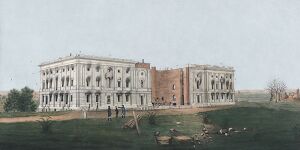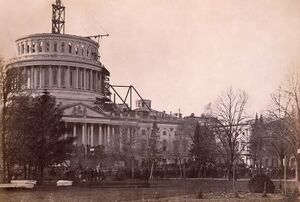What is the history of the United States Capitol Building?
Early in the history of the United State, the Capitol Building, or United States Capitol, was authorized and built in the newly formed capital of the US in Washington D.C. It was to serve as the seat of the legislative branch of the US government from 1800, when the legislative branch was moved from Philadelphia to Washington D.C. The site of Washington was seen as a compromise between Northern and Southern states which had disputed where the seat of government for the United States should be.
Contents
Construction and Early History
The history of the Capitol building begins with the passage of the Residence Act of 1790, which mandated a formal seat for the US federal government. Norther states would have preferred a site such as New York or Philadelphia as the likeliest place for the seat of the US government; however, after the federal government agreed to take on Revolutionary War debt from northern states, the northern states agreed to Washington D.C. becoming the newly built seat of government. The US government gave the transition period for the legislative branch to be transferred to D.C. 10 years, with this period lasting between 1790-1800, with Philadelphia serving as the temporary home of the branch. The French-American engineer Pierre Charles L'Enfant designed the new capital city of Washington D.C., where he planned for the 'Congress House,' as the Capitol was envisioned to be called, to be located on its present site on Jenkin's Hill (now called Capitol Hill). A broad avenue would connect the President's House (White House) with Congress House. Early on, the founders of the United State's used ancient Rome as their example. Thomas Jefferson, in particular, saw the Temple of Jupiter in Rome as an example of what the future Congress House would look like. In fact, Thomas Jefferson had pushed to change then name from Congress House to the Capitol after the hill in which the Temple of Jupiter stood, which was one of seven hills of ancient Rome.
After a competition held on what the Capitol would look like, where the winner would get $500, the architect architect William Thornton, inspired by the Louvre and the Paris Pantheon was chosen as the main design. A rival to Thornton, Stephen Hallet, a French architect, wanted a grander building and was very critical of Thornton's suggestion. Eventually, the two architect's designs were integrated to form much of the core of the Capitol. Later, Thomas Ustick Walter and August Schoenborn would also have great influence on the current building by designing the north wing and dome respectively. On September 18, 1793, President George Washington laid the foundation of the Captiol, with a ceremony taking place in which he and eight other Freemasons dressed in their masonic clothing. By 1800, the Capitol building was ready to be used for its designed purpose. Interestingly, early in its history the Capitol was also used as a church for Sunday services, with the speaker's podium serving as the pulpit. Although the Senate wing was not finished, on November 17, 1800 both the House and Senate were in session in the Capitol for the first time. By 1812, both wings of the Capitol were complete (Figure 1).
Later History
The first time the Capitol was breached was on August 24, 1814, when British forces entered Washington and burned parts of the city and Capitol. No breach would occur again until the events of January 6th, 2021. Within a year of the first breach and partial burning, the Capitol was being reconstructed, led by two military engineers (George Bomford and Joseph Gardner Swift). During reconstruction of the building, Congress continued to meet but in another building called the Old Brick Capitol that was demolished in 1929. The Capitol was reused for its legislative purpose continuously since 1819. By 1824, the original dome was also completed (Figure 2). In 1850, the building was significantly expanded to include the new House and Senate wings. The original dome was replaced with a new cast-iron dome that was much larger than the original low, timber-framed design (Figure 2). Thomas U. Walter designed the dome to be 100 feet, with inspiration come from Les Invalides in Paris. A significant part of the construction in the 1850s was carried out slave labor. The Statue of Freedom was placed on top of the dome in 1863, with the dome completed that year. The rotunda is perhaps the oldest and most distinct feature inside the building, which still encompasses the 1800 original smaller center. The grounds around the Capitol were extensively redesigned using Fredrick Olmstead's designs between 1874 to 1892. He also recommended new terrace extensions to the north, west, and south sides of the Capitol that have since been completed. New additions occurred to the East Front of the Capitol in 1904, as the large dome and its weight put extra strain on the building. In 1958, the East Portico was extended. Corinthian columns from the original building were also replaced as part of this larger project, with the original columns now used as part of a large display in the National Arboretum. Since 1960, the Captiol has been declared as an official National Historical Landmark in the United States. In 1993, on September 18, 1993, the Capitol's bicentennial was celebrated by re-enacting the masonic ceremony conducted by Washington and others, with Senator Strom Thurmond, a Freemason, leading the ceremony. Until 1981, the East Front of the Capitol was used for Presidential inauguration; the West Front has been used since 1981 for this event.
Recent History and Key Events
On December 2, 2008, the United States Capitol Visitor Center opened to the public, the same date the dome finished in 1863, with the building dedicated to tell the history of the site and act as a starting point for tours of the Capitol. The center was built underground on the east side of the Capitol in order to keep the main view of the Capitol Building and Grounds clear of obstruction, with the building itself being about 580,000 square feet. Over the last decade in 2012-2016, extensive restoration has taken place on the building. Roughly $61 million had been appropriated for external renovation, while over $20 million had already been spent on work around the dome. From 2014-2016, extensive scaffolding covered the dome. The work was also pushed quickly so that the 2017 inauguration of President would not have the scaffolding as part of the view. The work was finished just prior to the 2016 election in September of that year.
In addition to inaugurations that have taken place in Washington D.C. since 1801, the Capitol has been part of key historical events. Every year, the building serves as a key site for Independence Day celebrations and fireworks as well as National Memorial Day concerts. In Martin Luther King's famous March on Washington in August 1963, the Capitol was not used as the site of the events and speech since the goal of the march was not to make members of Congress feel under attack or siege but rather that they were part of the process of creating a more equal society. Many other protests, including against the Vietnam War and Iraq war, were held near the Capitol and along the National Mall. Outside of senators, presidents, and other key or major government officials who have been lain in state at the Capitol, officers Jacob Chestnut and John Gibson were also given that honor in 1998 after a shooting incident at the Capitol building, with Chestnut being the first African American to be given that honor. Rosa Parks become the second African American to be given that honor. In 2018, Billy Graham became the fourth private citizen without having held a government role to have the honor of lying in state. Pope Francis, in 2015, became the first Pope to given a joint address to Congress. On January 6th, 2021 the capitol was breached for the second time in its history, with four rioters and one police officer killed in the resulting melee.
Summary
Few buildings have symbolize United States government and democratic ideals as the Capitol building. The building has seen a fair number of events over the last two hundred years that include controversy or dealt with difficult events, such as the use of slaves to build a large part of the present building. Given the important symbolic and actual value the building has for many in the United States, and by an extension to many democratic countries, the building and site continue to attract protestors and marches, including the events that turned violent in 2021.

